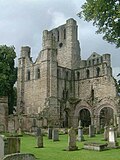
This article lists the oldest extant freestanding buildings in Scotland. In order to qualify for the list a structure must:
Contents
- Main list
- Neolithic and Bronze Age
- Iron Age
- Early Historic period
- 12th century
- 13th century
- Castles
- Religious buildings
- By council area
- Other structures
- Undated buildings
- Other prehistoric constructions
- See also
- Notes
- Footnotes
- References
- be a recognisable building (defined as any human-made structure used or intended for supporting or sheltering any use or continuous occupancy);
- incorporate features of building work from the claimed date to at least 1.5 metres (4.9 ft) in height and/or be a listed building.
This consciously excludes ruins of limited height, roads and statues. Bridges may be included if they otherwise fulfill the above criteria. Dates for many of the oldest structures have been arrived at by radiocarbon dating and should be considered approximate.
The main chronological list includes buildings that date from no later than 1199 AD. Although the oldest building on the list is the Neolithic farmhouse at Knap of Howar, the earliest period is dominated by chambered cairns, numerous examples of which can be found from the 4th millennium BC through to the early Bronze Age.
Estimates of the number of broch sites throughout the country, which date from the Iron Age, range from just over 100 to over 500. [2] However, only a small percentage are sufficiently well preserved for them to be included here and some of those that could be remain undated.
As there are relatively few structures from the latter half of the first millennium AD and a significant number from the 12th century, the latter group is placed in a sub-list. There are larger numbers of extant qualifying structures from 1200 onwards and separate lists for 13th-century castles and religious buildings are provided. As the oldest buildings in many of the council areas in the more urbanised Central Belt date from after the 14th century, a separate list showing oldest buildings by council area is provided.

There is also a supplementary list of qualifying structures for which no confirmed date of construction is available and a short listing of substantial prehistoric structures that are not buildings as defined above.
























































































































